ImaHima in Jap@n Inc magazine (June 1, 2001)
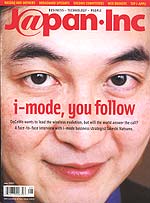
Takeshi Natsuno: The Incrementalist
Jap@n Inc.
(an excerpt)
If you ask Takeshi Natsuno about i-mode, or if you read his recently published book, “i-mode Strategy”, you’re likely to come away impressed with his entirely self-consistent vision of how the world’s No. 1 mobile Internet service should evolve — which is no surprise, considering Natsuno is one of i-mode’s master architects.
…On i-mode services and features required to build a global base:
Again, this relates to complexity. If I could imagine everything required to build a global base, that would not be faithful to complexity theory. In the past three years in Japan, many things have happened — many
unexpected things. Take the growth of the entertainment business on i-mode. I didn’t expect so much entertainment content could really work on the i-mode platform. And I’m sure we’re still missing a lot of business opportunities. As content providers buy in and create more complexity all over the world, I’m sure many people will start to find their own content niche.
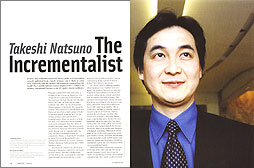 A good example is ImaHima. The ImaHima founder is originally from India, I think, but he found a new niche area on the i-mode market. [Note: ImaHima is a social networking, dating, and matchmaking service on i-mode.] His viewpoint is totally different from the Japanese one. Oh, sure, he’s a good Japanese speaker, but his viewpoint is different from most Japanese, who tend to think, ‘It’s very bad to do something different from others.’ That’s why we’ve aligned with AOL. I’m getting a lot of feedback from the AOL people; they are getting a lot of feedback from me. All this interaction continually contributes to i-mode’s growth. That is the power of Sony — that is the power of a global company, right? If we speak only to Japanese people, we’re not going to be so successful. We have to be global. That’s what all industries have already discovered. That’s what makes the Net very interesting.
A good example is ImaHima. The ImaHima founder is originally from India, I think, but he found a new niche area on the i-mode market. [Note: ImaHima is a social networking, dating, and matchmaking service on i-mode.] His viewpoint is totally different from the Japanese one. Oh, sure, he’s a good Japanese speaker, but his viewpoint is different from most Japanese, who tend to think, ‘It’s very bad to do something different from others.’ That’s why we’ve aligned with AOL. I’m getting a lot of feedback from the AOL people; they are getting a lot of feedback from me. All this interaction continually contributes to i-mode’s growth. That is the power of Sony — that is the power of a global company, right? If we speak only to Japanese people, we’re not going to be so successful. We have to be global. That’s what all industries have already discovered. That’s what makes the Net very interesting.

On Our Radar Screen
ImaHima Inc
www.imahima.com
Founded in 1999 by ex-Andersen Consulting analyst Neeraj Jhanji, ImaHima (“Are you free now?”) is a socializing and scheduling service enabling mobile customers to locate and contact friends, schedule parties and events, meet new people, and find information and activities based on their current location via mobile phone (the service is now accessible from PC as well). Jhanji was one of the first foreigners to approach DoCoMo about setting up a social networking and meeting service for i-mode, but he was shown the door when it became apparent that ImaHima could also be used by ax-murderers and the like to meet up with unsuspecting victims (i-mode’s handlers were hypercautious about safety and security in the service’s earlier days). Undeterred, Jhanji went ahead and launched as an unofficial site, which quickly racked up users in the low tens of thousands based on word-of-mouth marketing. Since then, Jhanji has found a way to make the service acceptable to the nannies over at i-mode and has launched Version 2.0, which features more sophisticated personalization tools and a searchable directory, as an official i-mode site. ImaHima is now on all the Japanese mobile Webs, and is looking at expanding into Europe in WAP and SMS versions, spurred in part by some capital kicked in from AOL; the venture claims 250,000-plus users and more than 1 million page views daily. Next time an Indian national in Tokyo who doesn’t speak much Japanese offers you a low-paying job in a startup that has no revenue and no marketing, say “Yes” – like ImaHima, that venture may be going somewhere.
imaHima on CNN (May 15, 2001)
CNN interviews Neeraj Jhanji of imaHima about his mobile, location-based, social networking service (aired on CNN May 15, 2001).
imaHima in Japan Today (May 14, 2001)

How your mobile is morphing into a modern compass
Neeraj Jhanji, President, ImaHima Inc
The office of ImaHima is the impressively modern Ebisu Garden Place Tower. The area is a stone’s throw from Shibuya and a largely residential spot where the rents are sky high and the apartments fabulous.
Neeraj Jhanji had worked at consulting company Andersen Consulting Strategic Services in Tokyo for five years which helps explain why he speaks Japanese so well. From his warm manner and soft way of speaking, he seems a peaceful kind of guy. Yet he is succeeding in one of the toughest, most exciting businesses – mobile phone service.
ImaHima is Japanese and means “are you free now?” and is a perfect description of the company’s services.
It provides the framework for a mobile Internet community. By using its mobile phone service, subscribers can find their friends and exchange messages by phone or web interfaces.
Because of its uniqueness in Japan and the large number of i-mode subscribers, there are already more than 250,000 users of ImaHima since it started in December 2001.
But times are tough for businesses, especially tech-based ones, in Japan and the rest of the world. So how did Jhanji do it? JapanToday reporter Takanori Kobayashi asked Jhanji to let him in on a few trade secrets.
What is ImaHima’s company culture?
It’s very multi-cultural. I am from India and we have ten employees, who come from around the world including India, Japan, England, America, Russia, and Switzerland.
While we all have different backgrounds, cultures and points of view, there is a lot of respect. The office is also very open. There is no demarcation between us when we have meetings and people come and go from my office freely.

How did you come up with the idea for your service?
When I was working for Andersen I was having lunch one day and looking around at the people also eating in the restaurant. I wondered if any of my friends were nearby and whether I could lunch with them, I always carry a mobile and so did they.
Then I thought what if my phone told me where my friends were and I realized this was a good idea for a service.
How does your service work technically?
Users tells us where they are from a list, for example, Shibuya or Ebisu in Tokyo or say Sapporo in Hokkaido. We put the information into our databases on a web server, and show the pages displaying users’ locations. They can then be accessed and you can find your friends.
Who are your competitors?
There are so many companies providing different kinds of software on mobile phones but there is very little available telling you about location. I know one company in Israel, which has the same kind of the service we do. I don’t think many companies provide services to keep in touch with friends on mobile phones.
How does the company make money?
When using ImaHima through i-mode, you pay monthly but you get extra services like sending greeting cards. You can use the location service for free by using your PC or a mobile phone. I want to keep it easy for users to experience ImaHima.
What is the most difficult part of your job?
Managing the company itself is a challenge for me. In between creating products, hiring people and building relationships there’s a lot to do. The most difficult part for me is figuring out not only how to create interesting products but also how to make them valuable parts of the business. Otherwise, the company won’t last long.
Why did you start this business during a downturn?
For two reasons. First, I was working at the consulting company and was already established here with a family and friends. Also, I could speak some Japanese and felt very comfortable here. And the second reason, when it comes to mobile phone businesses, this is the only the country on the planet with a high penetration of mobile users of the Internet.
Who is funding your venture?
AOL is the largest investor of ImaHima. Also, CTR is a venture capital company and one of our investors. Its CEO, entrepreneur Roger Boisvert, has helped a lot. Boisvert’s companies are very successful. When I met Roger, I asked him for details on how to make this company successful.
Do you have other applications?
Our strategy is a little different from other mobile players such as Cybird or Bandai. They offer contents like games, which you enjoy but then you’re easily bored, and also fortune tellers, which get boring quickly too. These products are all short lifetime products.
We’re focussing on creating a relationship between individuals, because communities are not short term things. They take time to grow. I’m thinking about similar applications for teenagers and people outside of Japan, like travelling businessmen.
Are you making a profit yet?
We hope to break even by the end of the year. By the way, now, our focus has to be tight to make sure our products are successful. Sure, making profit is really important, but so is helping people to keep in touch with friends. the main push for our business. I know building a successful business will take a long time.
Who in business do you respect most?
Takeshi Natsuno, a DoCoMo employee. He’s one of the founders of i-mode. He helped build the entire business model for i-mode from 1997 and made all the big decisions to make it successful. He has so much energy and ideas and is very practical. Another person is Mike Yoshii who belongs to a law firm which helps ImaHima. People like him work very hard to help venture businesses get funding and support. Of course there are many others through history but these two are contemporaries.
What do you think of the future of the Internet in Japan?
Many Japanese people are coming online and using email so it’ll be more comfortable to use the Internet and to get information. Internet access by mobile phones is growing, and it’s becoming a daily thing, not a novelty. I cannot predict the future but personally I think that if it’s possible for parents to be able to see their children’s face from the screen of a mobile phone, it’ll be great.
- Takanori Kobayashi
imaHima in Wired magazine (April 2001)
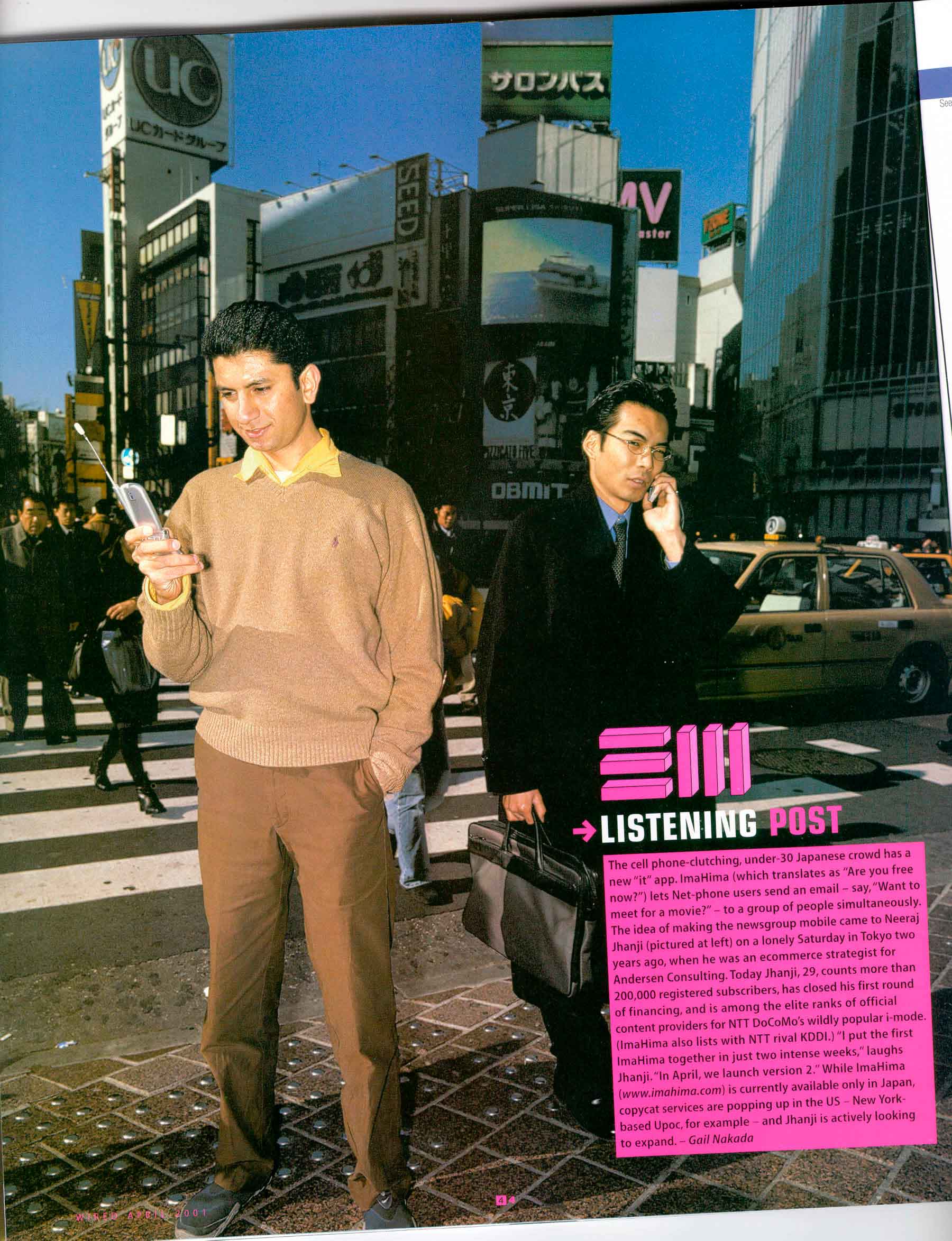
Listening Post
The cell phone-clutching, under-30 Japanese crowd has a new “it” app. ImaHima (which translates as “Are you free now?”) lets Net-phone users send an email – say, “Want to meet for a movie?” – to a group of people simultaneously. The idea of making the newsgroup mobile came to Neeraj Jhanji on a lonely Saturday in Tokyo two years ago, when he was an ecommerce strategist for Andersen Consulting. Today Jhanji, 29, counts more than 200,000 registered subscribers, has closed his first round of financing, and is among the elite ranks of official content providers for NTT DoCoMo’s wildly popular i-mode. (ImaHima also lists with NTT rival KDDI.) “In April, we launch version 2.” While ImaHima (www.imahima.com) is currently available only in Japan, copycat services are popping up in the US – New York-based Upoc, for example – and Jhanji is actively looking to expand.
- Gail Nakada
imaHima on BBC (April 2001)
BBC interviews Neeraj Jhanji of imaHima about his mobile, location-based, social networking service (aired on BBC in April 2001).
ImaHima in Asian Business (March 2001)
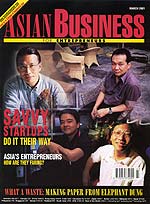
 Straight Talk: Calling the Wired Generation
Straight Talk: Calling the Wired Generation
Look out! Neeraj Jhanji wants to know who you are and where you’re going
Japan is a relationship-driven country and not only for securing company contracts. Who you know and how well you keep in touch with them drives social and business interaction on every level. Wireless technology has been the answer to Japan’s social networking imperative and a swift new communications platform, ImaHima, is making Japanese networking faster and easier than ever before.
Ironically it was not a local who launched the hot new technology, but a 28-year-old Indian, Neeraj Jhanji. The multi-lingual Jhanji, fluent in English, Hindi and Japanese, holds an undergraduate degree in electrical engineering from the University of Delhi and won a Fujitsu Asia-Pacific MBA scholarship.
Before hitting the entrepreneurial trail, Jhanji worked in technical and consulting roles for Siemens and Unisys and was a senior consultant in e-commerce strategy for Andersen Consulting in Tokyo. Together with his partner and vice president of technology and operations, Yoshiatsu Kitagawa, Jhanji has big plans for his fledgling business.
ImaHima, which translates as “are you free?”, allows mobile Net-phone users to send email simultaneously to everyone on their list or to leave messages on their member file so friends or business associates in their group can coordinate schedules.
In Shibuya and want to meet friends for dinner? ImaHima lets them know where you are and when to meet. Lonely in Ginza? Check ImaHima and see if any of your buddies or associates have left a note that they are passing through the same area. Value propositions to businesses include wireless advertising and opt-in sites for updates on dining, shopping, coupons and special offers, giving business clients access to real-time, highly-segmented area marketing.
Jhanji is planning to launch an even more user-friendly version of ImaHima 2 this April and he will be backed up by the installation of new technology architecture capable of handling the higher levels of traffic the company expects.
Launched on December 15, 1999, the ImaHima website is currently getting close to an average 800,000 hits a day, with 50% of its 200,000 registered users coming back within a week. With an average age of 25 and a female-male ratio of 1:3, the site is right on the demographic target for avid young Japanese Net-phone users. ImaHima is working with Japanese telecom carrier KDDI and plans to be included in the chosen few for Japan’s hottest wireless listing – NTT DoCoMo’s i-Mode official content sites.
ImaHima recently completed first-round funding and Asian Business caught up with the company’s young CEO in his new high-rise office in the fashionable shopping and business district of Ebisu, Tokyo.
AB: Tech stocks are down, venture capital is getting tighter, how difficult was it to interest investors in ImaHima and its communications technology?
 JHANJI: We started looking seriously at funding from May and closed in December. It took longer than we initially planned due to the crash in tech stocks last March. VC [venture capitalist] investors needed time to recover and plan ahead. After the crash, the media was looking at wireless technologies as “the next big thing”.
JHANJI: We started looking seriously at funding from May and closed in December. It took longer than we initially planned due to the crash in tech stocks last March. VC [venture capitalist] investors needed time to recover and plan ahead. After the crash, the media was looking at wireless technologies as “the next big thing”.
Because ImaHima’s technology and concept bridges both communications and the Internet, we found ourselves in a much stronger position in regards to investor interest than a dot com, especially in regards to global companies. The market reaction was very positive to us.
AB: Although the news is still confidential, I gather your first investors are largely foreign capital companies in Japan. Were they looking for a venue through which they could catch the wireless wave?
JHANJI: Actually, it was a conscious choice on our part. In general, Japanese companies do not have that much experience in venture capital. It’s easier and faster to work largely with foreign-based investors.
For example, given their lack of experience, Japanese VCs do not typically understand the concept of common shares and preferred shares — for them it all has to be common shares. If your company then tries to bring in a foreign investor, that investor will insist on preferred shares. It’s very difficult to mix the two.
If your venture sides with a Japanese VC, then you need to keep the investors Japanese. Japanese investors also are not comfortable with the high valuations common to high-tech firms, nor are they able to reach decisions quickly. Foreign investors, VCs, know what to look for right away: what stage of business evolution is the company in; what’s the team’s background and strengths; what kind of contracts does the company have; what kind of users, revenues and future plans. Since we were able to get a positive response from the foreign market, we focused on them. But yes, being a wireless Internet company did help.

AB: Was the technology difficult for your investors to grasp at first?
JHANJI: The strong part of what we’re doing is the concept rather than the technology. The core concept is “where are you now?” (ImaDoko?). Keeping in touch with people is central to what mobile phones are all about, especially with the pace of life in the city and everyone on the move all the time. When I first came up with the basic idea for ImaHima, I thought, “what if a company knew where mobile phone users were?” It could sell that information to marketers who, with permission from these people, would then market coupons or value added services through an intercommunication tool. I also thought the company could generate revenue by charging a subscription fee to the end user through the phone bill. To my surprise I found no one else was doing it. I patented the technology and the concept sold itself.
AB: Now that you have your funding, will you be focusing more on expanding and refining services for your subscriber base or sales for location-based advertising?
JHANJI: Location-based advertising is very new to everyone in this market. Although awareness is growing, consumers aren’t yet focused on it. Some do promotions work in this venue and some don’t, depending on the product.
Why something didn’t work can be difficult to explain to clients. Because it’s so new, the sales end of location-based ads is a very labour-intensive process.
Right now we don’t have the manpower to make the advertising side profitable. It’s a niche, but it’s not a money-spinner. We’ve decided that our revenue model will continue to be subscription fee based with some merchant advertising.
That said, we will continue to spend time educating not only customers but also client firms, getting merchants warmed up to the concept and used to these new techniques.

AB: You can’t run a wireless business without the question of DoCoMo coming up. How does iMode relate to your business model?
JHANJI: When I was finally ready to show ImaHima to the world, I called DoCoMo right away and said: “I have a product that will make you money.”
AB: Were they excited
JHANJI: They loved it! But they said it was too early in the evolution of their wireless model to use it yet. If you look at what iMode has been doing, it’s really quite primitive. Instead of community-based services, they sell chunks of content delivery, like magazine subscriptions.
As a communication enabler, providing community-based services should be one of DoCoMo’s main efforts. One problem is they are such a powerful brand that they worry over their image. Community or chat sites have often been corrupted for enjokosai, or prostitution services. The potential for misuse has made them wary.
At ImaHima, we have had public channels as well as private ones, and that’s where I met my roadblock in getting included on their official contents list.
However, we were first to market, we had a very good name and a cool concept, and we got noticed in a lot of media, the Wall Street Journal, and European and Japanese media from television to magazines and newspapers. Because of the publicity, our users grew to 200,000 within a year with no advertising expenditures on our part.
We listed with Japanese telecom group KDDI and DoCoMo started sitting up and taking notice, saying “they’re not getting any help from us, but they’ve got more page views a day than most of our official sites”. In our new ImaHima2 redesign, we have decided to eliminate the public channels. DoCoMo has become more receptive; we’ve received verbal approval and are awaiting a written contract.
AB: What part in ImaHima’s game plan does your partner Yoshiatsu Kitagawa play?
JHANJI: I put ImaHima up on the web in December 1999 and Yoshiatsu came in March of this year. I’d known him for five years from my first days at Andersen when I was just an intern.
He has a lot of technical expertise to bring to the equation and a background in project management, which is essential. I’m not a hard-core developer anymore, having him there gave me the freedom to concentrate on growing the business.
AB: And is it growing?
JHANJI: There are doors opening up for ImaHima outside of Japan. We have had conversations in Europe and other major telecoms in Asia about bringing the service there. It’s a scalable model. Our investors have given us the funding we need to build on our success and go global.
- Gail Nakada
ImaHima in Capital Magazine (in French) (March 2001))
Dossier International
De notre envoye special au Japon, Jean Botella
(an excerpt)
Grace au succes de l’Internet mobile, l’Archipel commence a combler son retard. Comme a New York ou a Paris, les start-up de Tokyo ont leur quartier, la «Bit Valley». Mais ces jeunes pousses ont du mal a ser financer.
…Pour entrer dans les locaux, on vous reclame au minimum dix mois de caution», deplore Neeraj Jhanji, 29 ans, fondareur d’un site communautaire de start-up ont recours au systeme D. «J’ai installe la societe dans mon appart et, le soir, je vais dormir a l’hotel», raconte Neeraj, un ancien d’Andersen Consulting…
ImaHima in Entre (Japanese) (December 1, 2000)

Entre People: 今月の「いま、暇?」
「今どこにいるの?」から始まる新しい携帯Webサービス事業は盛田昭夫に憧れたインド青年の夢
ジャンジさんが、 Web携帯電話コミュニケーションサービスを思いついたのは、昨年夏、彼女にふられて週末がヒマになったから。デートに費やしていた時間が文字どおり「イマヒマ」になってしまったのだ。
「渋谷の街では、女の子たちがみんな携帯電話を使っていますよね。誰もモバイルコンピュータなんか使わない。それを見て、友達どうしが今どこで何をしているのか、連絡を取り合える情報提供サービスのアイデアが浮かびました」
ベースはインターネット。「imaHima」に登録した仲間たちが今いる場所、行動の内容、時間を簡単に交換できる。たとえば「今、109のエゴイストで買い物中、いっしょに晩ご飯が食べられる子はいない?」ということを入力すれば、登録している仲間たちが確認してメールを送ったり、電話をかけてくる。そのグループ全員の動向がすぐにわかるという便利な機能だ。そのほか、オリジナル機能の「メイト招待状」「名刺交換」などを使って、新しい仲間作りもできる。確かに、携帯を使った頻繁なコミュニケーションが生活の一部となっている若者には、とても喜ばれるサービスかもしれない。
「それだけではありません。ロケーションを絞ったマーケティングに大きな力を発揮します。たとえば、渋谷のピザのお店が、新しいメニューを紹介する。そうすると渋谷界隈に集まっている若者たちを引き寄せることが可能です。先日は、小柳ゆきさんの新しいCD発売に合わせて、ユーザー全員に新曲の着メロを提供しました。その当時のユーザーは8万人。そのうち15%が週末に着メロにアクセスしたんです」
これは相当の効果というべきだろう。ただし、「imaHima」に登録している会員の携帯に何か新しい情報が届いたとしても着信を知らせることはしない。あくまでユーザーの自発的なアクセスが基本である。
「レストランなどの情報を提供するサービスはほかにもあるけれど、うちのサービスは『いまどこにいるか』から始まるところが特徴です。いる場所の近くにある美容院とか映画館の情報が手に入ったら便利ですよね。それをさらに進めて『席が空いているか』までわかるようにしたいんです。すごく空いているときは値引きしてくれるとかね(笑)」
反響は上々で、昨年末に始まったサービスのユーザーが9月上旬に15万人を超えた。この財産を使えば、さまざまなビジネスチャンスが生まれるだろう。現在ビジネスモデル特許も出願中だ。
インドのデリー大学在学中に、英訳された盛田昭夫氏の『メイド・イン・ジャパン』を読んで感動したというインドの青年は、今ジャパニーズ・ドリームの実現を目指す。しばらくはお里帰りもおあずけ。世界から注目される人材大国・インドが生んだ新星の今後に注目したい。
イマヒマ(株)
代表取締役社長
ニラジ・ジャンジ[29]
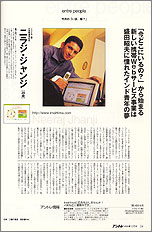 プロフィール
プロフィール
1971年インド・ニューデリー生まれ。デリー大学で電子工学を学び、シーメンス、ユニシスのインド法人で働いたのち、富士通の奨学生としてハワイ大学 MBAプログラムを受講し、MBA取得。その後アンダーセンコンサルティング(日本)で3ヶ月間研修を受け、終了後そのまま社員として勤務を続ける。現在は独立し、imaHimaに賭ける日々。
取材・文 ● 千葉望
imaHima on TBS “News no Mori” (September 27, 2000)
(in Japanese)
